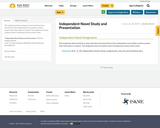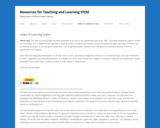
Post-reading activities for an independent novel study
- Subject:
- English Language Arts
- Material Type:
- Assessment
- Date Added:
- 03/08/2020

Post-reading activities for an independent novel study

This assignment allows students to share what they have learned from their independent novel studies as well as present their information in a speech. This assignment also has students meet in small group to discuss their novels.

This is an online inventory based on the work of Richard M. Felder and Linda K. Silverman. The quiz will determine preferences on four dimensions (active/reflective, sensing/intuitive, visual/verbal, and sequential/global).
This site includes the inventory, explanations of each of the areas, FAQs, applications of the learning styles, interesting articles including one on "Understanding Student Differences", and the validity of learning styles is explored.
**Make sure you open the 4 page "Learning Styles and Strategies" link after you take the inventory. This includes insightful information on how you can use the results to help yourself!**

You might have recognized the names of some of the Greek natural philosophers. They were individuals with quirky theories, and we have records about them. But they weren’t the only people making knowledge back in the day. Today, Hank takes us to India to talk Vedas, Maurya Empires, and some really good doctoring.

View this resource to find India-Inspired mandala projects and colouring pages.

Mosaics are a popular art form in India. This resource includes a few ideas to get students started with creating their own mosiacs!

View this resource to find three AMAZING India-inspired art projects for kids!

Information about various Indigenous artists and art styles in Canada.

The Children’s Health and Well-being Measure (ACHWM) is a tool that gives Indigenous communities and organizations an overview of the health and well-being of children and youth in their communities.
The measure offers insight into children's Spiritual, Emotional, Physical, and Mental wellness.
The survey is completed on a tablet that engages children and acts as a catalyst for honest conversation. The results are shared with each child or youth in a visual form on the Balance Chart.

This is a collection of resources to assist with infusing Indigenous knowledge, culture and values into the Financial Literacy Module 1: Why Money Matters (Introductory core)- Explore the purposes of money. Indigenous Elder Interivew Videos: https://opentextbooks.uregina.ca/financialempowerment/back-matter/video-interviews-with-elders/

This is a collection of resources to assist with infusing Indigenous knowledge, culture and values into the Financial Literacy Module 2 The Decision-Making Process (core Introductory).Outcome: Apply decision-making strategies to various personal and community financial scenarios.

This is a collection of resources to assist with infusing Indigenous knowledge, culture and values into the Financial Literacy Module 2 The Decision-Making Process (core Introductory). Some excellent resources include the NACCA Financial Workbook for Indigenous Women, The Money Stories series and the Native STAND booklet.

Bright, beautiful, interactive and simple to use, Managing your money offers a series of seven worksheets to help Indigenous individuals and families to set and work towards money goals. Each financial topic and activity features artwork by Simon Brascoupé paired with a teaching from the animal world that draws on their skills, strengths and experiences in managing resources. These worksheets are designed to facilitate one-on-one conversations or to be used in financial education workshops (and in fillable pdf format) They can be used in the order they appear, or in a different order that fits best with the individual. This resource also includes recorded webinar, with faciliator guide, blank slides to make your own presenation, and full booklets in English, French, Cree and Ojibwe.

The National Centre for Collaboration in Indigenous Education connects communities with each other to share their stories about Indigenous education across Canada and around the world.
Playlists of short films are available.

This site includes the following: (plus other information pertaining to Aboriginal Education in Manitoba and Canada)
It's Our Time: First Nations Education Tool Kit Teacher's Guide (National and Manitoba)
Creating Racism-Free Schools through Critical/Courageous Conversations on Race
Critical/Courageous Conversations on Race: What your child is learning at school and how you can help

This document helps support students and teachers wishing to engage with Indigenous perspectives in science. It also covers why it is important to connect to local Indigenous communities, provides suggestions on how to develop student understanding, and shares examples of how student science research can directly connect to the
Canadian Truth and Reconciliation Calls to Action.
Also check out the Indigenous Engagement Starting Points Checklist which provides a list of Indigenous groups and/or individuals you/your students can reach out to, to start this connection. A question checklist is also provided to help support those starting discussions.

More and more Indigenous communities are looking into agriculture as an economic opportunity and what it means for First Nation’s people and their future.
In this video, the leaders of Pelican Lake First Nation talk about the positive effects farming has had on their community including the creation of jobs and the long-lasting benefits for their younger generation.

More and more Indigenous communities are looking into agriculture as an economic opportunity and what it means for First Nation’s people and their future.
In this video, the leaders of Pelican Lake First Nation talk about the positive effects farming has had on their community including the creation of jobs and the long-lasting benefits for their younger generation.

Bill Lomax, President & CEO of First Nations Bank of Canada speaks about Indigenous Financial Nation Building and the Future of Indigenous Business. Bill shares present and future factors influencing the financing of Nation-building in Indigenous communities from the perspective of the only Indigenous-owned bank in Canada. From new settlements made between Indigenous Nations and the federal Crown to new business partnerships and ventures between Nations, a series of financial and social pressure points and how they could be tackled will be highlighted.

Discover the history, legal battles, and progress surrounding Indigenous land rights in Canada, highlighting their cultural significance and ongoing struggles for recognition.